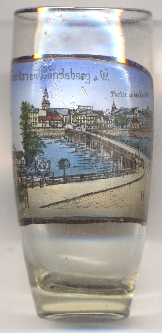

|
| POLSKA | POLAND |
| województwo: Lubuskie | voivodship: Lebus |
| miasto na prawach powiatu: Gorzów Wielkopolski | city: Gorzów Wielkopolski |
 Gorzów Wielkopolski (German: Landsberg an der Warthe) is situated at an elevation of 19 m on the
river Warta (German: Warthe) in the north of the Polish voivodship Lebus. As the seat of the voivode (governor),
Gorzów is one of the capitals of the voivodship, the other capital being Zielon Góra as seat of the
government and parliament. The municipality has a populatin of about 123,700 (2019).
Gorzów Wielkopolski (German: Landsberg an der Warthe) is situated at an elevation of 19 m on the
river Warta (German: Warthe) in the north of the Polish voivodship Lebus. As the seat of the voivode (governor),
Gorzów is one of the capitals of the voivodship, the other capital being Zielon Góra as seat of the
government and parliament. The municipality has a populatin of about 123,700 (2019).
The German name Landsberg an der Warthe dates back to 1257, while the Polish name Gorzów, then written as Gorzew is known from Polish maps and historical books dating back to the 19th century or perhaps earlier. During the reign of the first Polish monarchs of the Piast dynasty and until the mid-13th century, the land where the river Kłodawka meets the Warta was the location of a defensive fort established by the Piasts. In 1249 the Lubusz land to the west was sold to the Ascanian Margraves of Brandenburg and Landisberch Nova (named after Altlandsberg in Brandenburg) was founded on the site in 1257. After a war broke out over control of the region in 1319, the town came under control of the Duchy of Pomerania, but by 1325 it fell to Brandenburg again. In 1373 the city became part of the Lands of the Bohemian Crown (or Czech Lands), ruled by the Luxembourg dynasty. In 1402, the Luxembourgs reached an agreement with Poland in Kraków. Poland was to buy Gorzów and the surrounding region, but eventually the Luxembourgs sold the city to the Teutonic Order. In 1454, after the Thirteen Years’ War broke out, the Teutonic Knights sold the city to Brandenburg in order to raise funds for war against Poland. In 1701 Landsberg (Gorzów) — like all of Brandenburg — became ruled in personal union with the Kingdom of Prussia. In 1815, in the course of an administrative restructuring, the town became part of Prussia's Province of Brandenburg. The city, like all of Prussia, was included in the German Empire in 1871 during the unification of Germany. After World War II, the city became part of Poland in accordance with the provisions of the post-war Potsdam Conference.Most of the remaining German population was expelled, and the last original inhabitants were forced to leave the city in the early 1950s. Not having had an agreed Polish name, the town was renamed Gorzów nad Wartą in 1945 and finally Gorzów Wielkopolski in 1946.

 St. Mary's Cathedral [far left, no. 3924, and near left, no. 4799: right picture: background left]
is the seat of the Catholic Diocese of Gorzów. It is the oldest building in the town, being founded at the end of
the 12th century on the site of a previous church. The church changed its denomination to Protestantism in 1537,
which was changed back in 1945 when the city was transferred to Poland. After World War II, the area of today's
diocese formally had remained part of the diocese of Berlin, but in fact was admministered
by administrators. The diocese of Gorzów was finally founded in 1972 (renamed in 1992 Zielona Góra-Gorzów.
St. Mary's cathedral is one of the two cathedrals of the diocese, the concathedral being St. Hedwig's in
Zielona Góra.
St. Mary's Cathedral [far left, no. 3924, and near left, no. 4799: right picture: background left]
is the seat of the Catholic Diocese of Gorzów. It is the oldest building in the town, being founded at the end of
the 12th century on the site of a previous church. The church changed its denomination to Protestantism in 1537,
which was changed back in 1945 when the city was transferred to Poland. After World War II, the area of today's
diocese formally had remained part of the diocese of Berlin, but in fact was admministered
by administrators. The diocese of Gorzów was finally founded in 1972 (renamed in 1992 Zielona Góra-Gorzów.
St. Mary's cathedral is one of the two cathedrals of the diocese, the concathedral being St. Hedwig's in
Zielona Góra.
The  Warthe bridge [far left, no. 3924, and near left, no. 4799: right picture: foreground right] (refered to as
'new bridge') was built in the 19th century. It was replaced in 1923–1926 by a reinforced concrete construction
(named Gerloff bridge). That later bridge was blown up by the German army in 1945, rebuilt after the war and reovated
and widened in 2006–2007.
Warthe bridge [far left, no. 3924, and near left, no. 4799: right picture: foreground right] (refered to as
'new bridge') was built in the 19th century. It was replaced in 1923–1926 by a reinforced concrete construction
(named Gerloff bridge). That later bridge was blown up by the German army in 1945, rebuilt after the war and reovated
and widened in 2006–2007.
The bottom left picture on glass no. 4799 [near left] shows a view of
 Friedeberger
Friedeberger
The church depicted in the background is the
 Konkordienkirche
Konkordienkirche
[https://de.wikipedia.org/wiki/Gorz%C3%B3w_Wielkopolski, https://en.wikipedia.org/wiki/Gorz%C3%B3w_Wielkopolski;
https://en.wikipedia.org/wiki/St._Mary%27s_Cathedral,_Gorz%C3%B3w_Wielkopolski,
https://de.wikipedia.org/wiki/Bistum_Zielona_G%C3%B3ra-Gorz%C3%B3w, https://en.wikipedia.org/wiki/Roman_Catholic_Diocese_of_Zielona_G%C3%B3ra-Gorz%C3%B3w;
https://pl.wikipedia.org/wiki/Most_Staromiejski_w_Gorzowie_Wielkopolskim]
![[scale]](lineal.jpg)